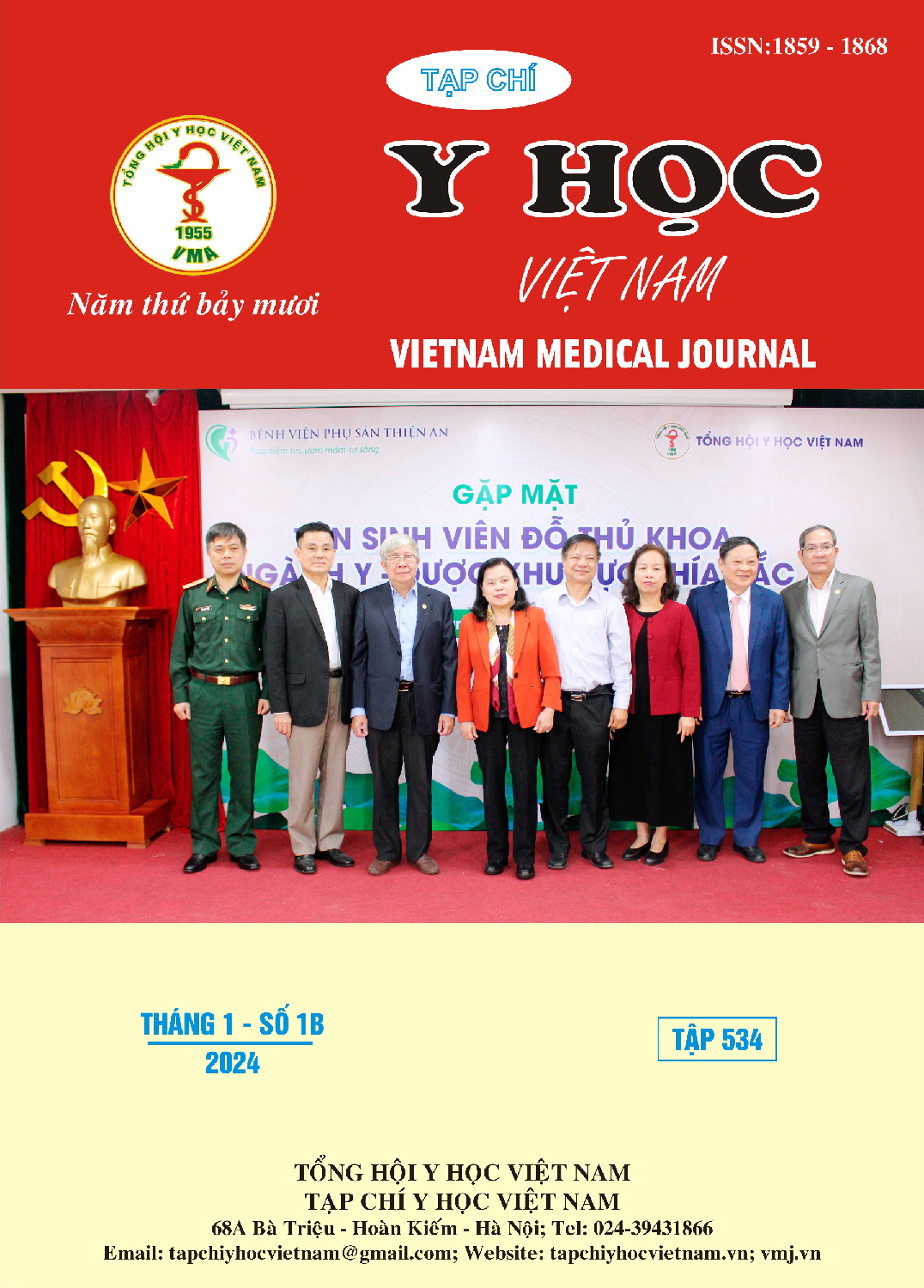PREVALENCE AND CHARACTERISTICS OF ATRIAL HIGH-RATE EPISODES IN PATIENTS WITH DUAL-CHAMBER PACEMAKER
Main Article Content
Abstract
Background and Objectives: Atrial high-rate episodes (AHREs) can be detected by cardiovascular implantable electronic devices. However, the prevalence and characteristics of AHREs have not been well identified. Methods: This prospective cohort study included 145 patients (median age 64.46 ± 16.38 years, 53.1% female) without atrial fibrillation (AF) from December 2020 to January 2022. AHREs was defined as a programmed atrial detection rate ≥ 190 beats per minute. Results: During 6 months of following up, AHREs occurred in 30.34% patients. There were statistically significant differences between the AHRE group and no AHRE group in terms of using anti-arrhythmic drugs before implantation ( p=0.001), history of paroxysmal supra-ventricular tachycardia (p<0.001), the percentage of premature atrial contraction on 24 hour Holter electrocardiogram (p<0.001) and left ventricular global longitudinal strain (LV-GLS) (p=0.036). Conclusions: The prevalence of AHRE during 6 months of follow-up was 30.34%. This study showed that history of supra-ventricular tachycardia and using anti-arrhythmic drugs, the percentage of premature atrial contraction on 24 hour electrocardiogram Holter monitoring and LV-GLS were statistically significant differences between the group with AHRE and no AHRE.
Article Details
References
2. Kirchhof P, Benussi S, Kotecha D, Ahlsson A, Atar D, Casadei B, Castella M, Diener HC, Heidbuchel H, Hendriks J, Hindricks G, Manolis AS, Oldgren J, Popescu BA, Schotten U, Van Putte B, Vardas P, Agewall S, Camm J, Baron Esquivias G, Budts W, Carerj S, Casselman F, Coca A, De Caterina R, Deftereos S, Dobrev D, Ferro JM, Filippatos G, Fitzsimons D, Gorenek B, Guenoun M, Hohnloser SH, Kolh P, Lip GY, Manolis A, McMurray J, Ponikowski P, Rosenhek R, Ruschitzka F, Savelieva I, Sharma S, Suwalski P, Tamargo JL, Taylor CJ, Van Gelder IC, Voors AA, Windecker S, Zamorano JL and Zeppenfeld K. 2016 ESC Guidelines for the management of atrial fibrillation developed in collaboration with EACTS. European journal of cardio-thoracic surgery : official journal of the European Association for Cardio-thoracic Surgery. 2016;50:e1-e88.
3. Hoàng QH, Trần SG and Đặng ĐM. Nghiên cứu các rối loạn nhịp nhĩ nhanh ở bệnh nhân mang máy tạo nhịp vĩnh viễn hai buồng trên 1 năm. Tạp chí Y học Việt Nam. 2021;Tập 504.
4. Kishima H, Mine T, Fukuhara E and Ishihara M. Left ventricular stiffness assessed by diastolic Wall strain predicts asymptomatic atrial high-rate episodes in patients with pacemaker implantation. Journal of cardiology. 2021;77:195-200.
5. Lamas GA, Lee K, Sweeney M, Leon A, Yee R, Ellenbogen K, Greer S, Wilber D, Silverman R, Marinchak R, Bernstein R, Mittleman RS, Lieberman EH, Sullivan C, Zorn L, Flaker G, Schron E, Orav EJ and Goldman L. The mode selection trial (MOST) in sinus node dysfunction: design, rationale, and baseline characteristics of the first 1000 patients. American heart journal. 2000;140:541-51.
6. Kim M, Kim TH, Yu HT, Choi EK, Park HS, Park J, Lee YS, Kang KW, Shim J, Sung JH, Oh IY and Joung B. Prevalence and Predictors of Clinically Relevant Atrial High-Rate Episodes in Patients with Cardiac Implantable Electronic Devices. Korean circulation journal. 2021;51:235-247.
7. Russo C, Jin Z, Sera F, Lee ES, Homma S, Rundek T, Elkind MS, Sacco RL and Di Tullio MR. Left Ventricular Systolic Dysfunction by Longitudinal Strain Is an Independent Predictor of Incident Atrial Fibrillation: A Community-Based Cohort Study. Circulation Cardiovascular imaging. 2015;8:e003520.
8. Olsen FJ, Biering-Sørensen SR, Reimer Jensen AM, Schnohr P, Jensen GB, Svendsen JH, Møgelvang R and Biering-Sørensen T. Global longitudinal strain predicts atrial fibrillation in individuals without hypertension: A Community-based cohort study. Clinical research in cardiology: official journal of the German Cardiac Society. 2021;110:1801-1810.


